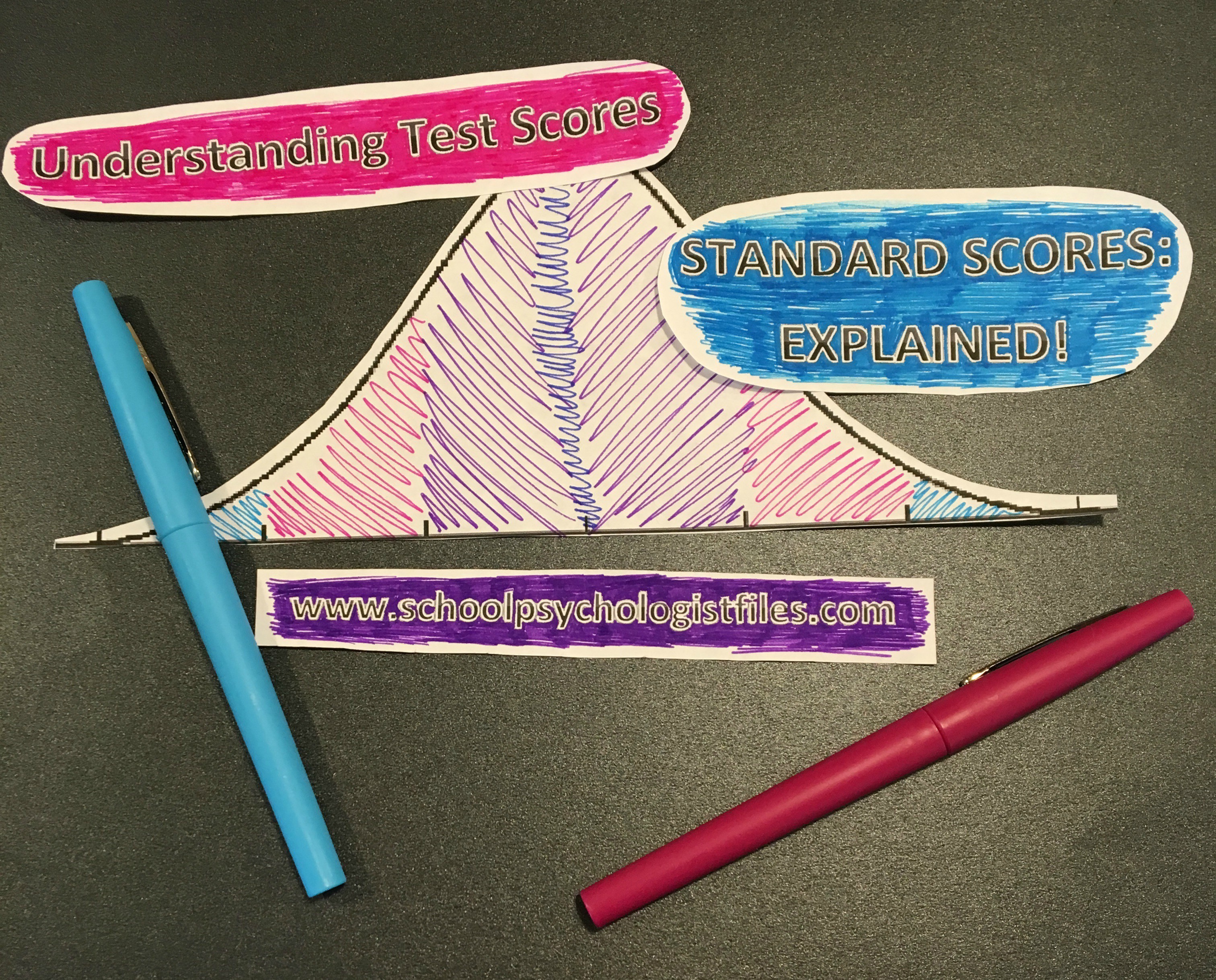Once a student has been evaluated for Special Education eligibility, there are a wide array of scores that can be difficult to sort through and understand. Parents, teachers, and anyone at an eligibility meeting need to be equipped to understand the basics of the types of tests that were used and what the scores mean.
Cognitive Assessments
A cognitive assessment provides information about a student’s intellectual strengths and weaknesses, as well as insight into his or her overall cognitive potential. The test gives general information about a student’s abilities compared to others his or her age in several areas. The tests are intended to be a predictor of how well and in what ways a child will learn new information. Remember that other factors must ALWAYS be considered. A high IQ does not guarantee success, just as a low IQ does not guarantee failure.
Some of the more commonly used cognitive assessments in schools are the Wechsler Intelligence Scale for Children (WISC-V), Differential Ability Scales (DAS-II), and the Woodcock Johnson, Tests of Cognitive Abilities (WJ-IV).
The cognitive assessment will have an overall IQ score. This score will be considered valid only if testing conditions were adequate and there is minimal variability in scores among the various scales on the assessment. When there is a significant scatter between the different areas, the overall score will not be representative of a child’s overall potential and one must look more closely at the scores in the Scales.
In addition to the overall IQ Score, the cognitive assessment will measure various processing areas. For example the WISC-V measures verbal comprehension ability, fluid reasoning ability, visual processing, processing speed, and working memory. The score in each area will indicate ability in the various areas measured. For example, the score in Processing Speed on the WISC-V will indicate a person’s ability to quickly and accurately process simple visual information.
The scores are obtained in a complicated and statistical way, not the percentage of questions answered correctly. Thousands of people were given the assessment and the results were standardized to determine various ranges of ability for each age. With the results of the sample population, norms were created. Percentile rankings were correlated with a person’s performance level based on the norms created from the standardized sample. Your child’s score will be a comparison of how he or she performed compared to the standardized sample. 68 % of the population will perform in the Average range. The farther away from the Average range one performs, the less typical the scores are.

The scores are typically described in Standard Scores. Standard Scores have a mean (average) of 100. Anything within 10 points from 100 is considered Average. Scores from about 90-110 are considered Average. Some assessments will vary slightly. Just outside of that range is the Low Average range (80-89) and the High Average range (110-119). Students performing in either of these ranges are slightly different from the norm, but still within expectations of the general public. High Average scores suggest somewhat stronger cognitive abilities, while a person with Low Average scores may struggle somewhat to keep up. The Borderline range is 70-79. Students in this range may significantly struggle in the classroom. However, they often will not qualify for special education services. Remediation or other strategies should be considered. Below 70 would be the Extremely Low range indicating a possibility of an Intellectual Disability (the scores alone will not diagnose). Three percent of the population will fall in this range. On the other end three percent of the population is estimated to fall in the gifted or Superior range (130 and above). Scores between 120-129 are considered Above Average. The wording for these ranges will vary from test to test.
The scales are comprised of a few individual tasks that measure differing aspects of the processing area. The student’s performance on the task is measured with a Scaled Score. The Average range on Scaled Score is 8-12.
In summary, scores on the cognitive assessment are actually intended to be a comparison to the general public. Think of the scores in terms of ranges. First, look at the overall IQ score and determine if that is a valid estimate of his or her ability. Second, look at each of the Scales to see how the student performed in the various processing areas. Third, look at the individual tasks within the scales. Ask your Psychologist for information as to what each of the tasks and scales measure.
Academic achievement tests measure specific academic skills compared to other children at the same grade or age level. They focus on Broad Reading, Writing, Math, and Oral Language skills and also different aspects of the broad areas. Within the Reading domain, there will typically be a task measuring comprehension, a task measuring reading fluency, a task measuring site word recognition, and a task measuring decoding. Math is typically broken down into computations, fluency, and a task measuring mathematical reasoning. Within the Writing domain, there will be a task measuring spelling, writing fluency, and the ability to express oneself through writing. The testing occurs in an individualized setting with a test examiner and the student. The examiner will help the student stay focused and complete the tasks, but will not provide assistance on test items.
Unlike classroom assessments that measure a specific skill that has just been taught, these tests measure basic academic skills. A student’s performance will be compared to other children of the same age. If your child just turned 9, his performance will be compared to others who just turned 9 in the standardized sample. The test measures the level of skills that have been acquired compared to “typical” 9 year olds. Like other standardized tests, achievement tests have also been normed with a standardized sample of children of all ages to develop a range of typical scores. Scores between 90-109 are typically the Average range and consist of the level of skills acquired by most children. 100 is the Mean and the farther away from 100 the score is, the more atypical. In a regular education classroom the majority of students would score in the Average range, Low Average range (80-89), or High Average range (110-119).
Typically, a student’s academic achievement scores will be quite similar to the cognitive ability scores. When the scores are well below measured cognitive potential, it may signify a Learning Disability if other factors are present. However, there are a variety of reasons that cause academic achievement to be discrepant from cognitive abilities.
Some of the most common tests of academic achievement include the Wechsler Individual Achievement Test, Second Edition (WIAT-II), Woodcock Johnson, Tests of Achievement, Fourth Edition (WJ-IV), and the Kaufman Test of Educational Achievement, Third Edition (KTEA-III).
Behavior rating scales provide information about particular aspects of a student’s behavior compared to other children of the same age and sometimes same gender. The rating scales may be global and focus on several areas or look more in depth at a specific behavior, emotional issue, or social issue. Rating scales are given to teachers, parents, or the student as a way to obtain standardized data about the severity of a concern. The rating scales have been standardized, by giving the scale to thousands of respondents. The makers of the rating scales, took those responses and developed a range of normal, “at-risk,” or “clinically significant,” and assigned scores to those ranges.
Behavior rating scales tend to use T Scores to report results. T scores have a mean of 50 with a standard deviation of 10. This means a score that falls at 50 or within 10 points above or below 50 is considered average, and typical of the population. The farther away from 50 a score falls, the more atypical it is. Each test tends to use their own classifications and ranges. It would be important to find out the specific range for the rating scale that was used. Often scores from 60-69 are considered “at-risk” and slightly atypical from the norm. It often means that more information should be obtained or the behavior monitored. Clinically significant scores are often those that are 70 and above. The term clinically significant means that the severity of the behavior is significantly different from the norm and indicates a strong possibility of a clinical problem. Rating scales are often used to assist in the diagnosis of ADHD or an Emotional Disability.
Rating scales alone do not diagnose any disorder. While a high score may be indicative of a possible problem, it should be used with other assessment methods before a diagnosis is made. For example, if depression comes out in the Clinically Significant range on a behavior rating scale, it does not necessarily mean your child is suffering from Major Depression. It does, however, indicate that it was reported that your child exhibits symptoms commonly associated with depression. More information will need to be obtained.
